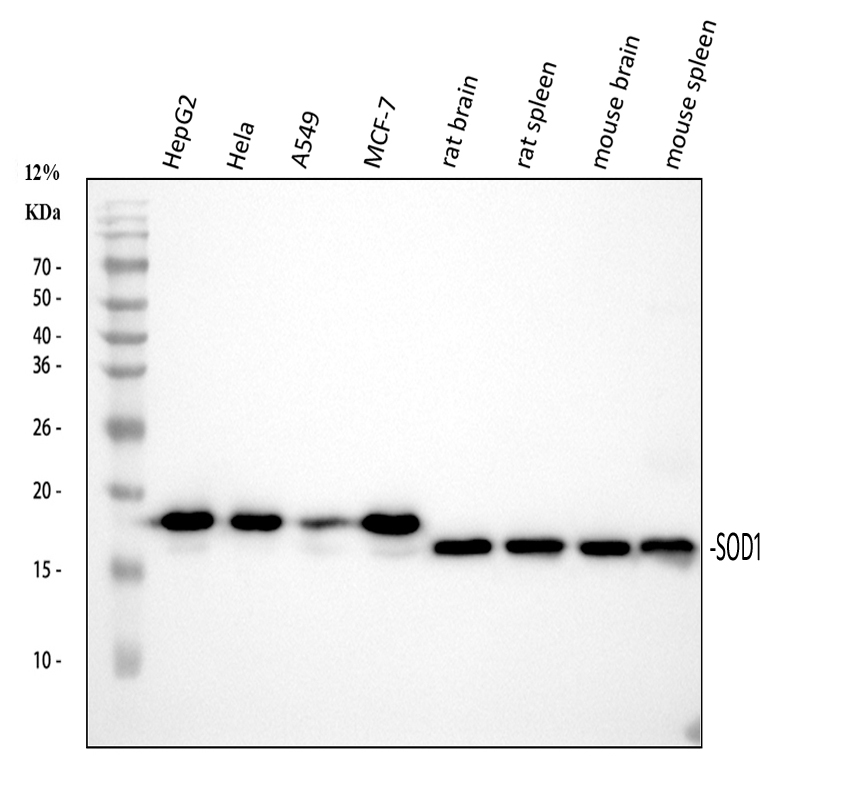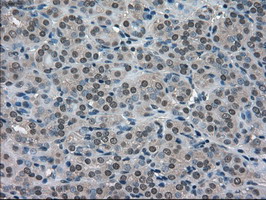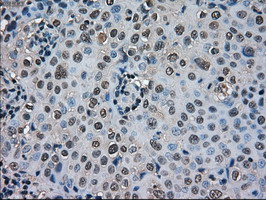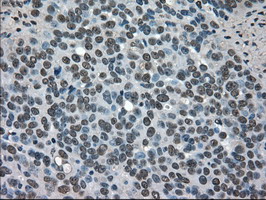| Western blot (WB): | 1:1000~2000 |
| Immunohistochemistry (IHC): | 1:50 |
| Flow cytometry (FCM): | 1:100 |

Western blot analysis of anti-SOD1 antibody (M00238-1). The sample well of each lane was loaded with 30 ug of sample under reducing conditions.
Lane 1: human HepG2 whole cell lysates,
Lane 2: human Hela whole cell lysates,
Lane 3: human A549 whole cell lysates,
Lane 4: human MCF-7 whole cell lysates,
Lane 5: rat brain tissue lysates,
Lane 6: rat spleen tissue lysates,
Lane 7: mouse brain tissue lysates,
Lane 8: mouse spleen tissue lysates.
After electrophoresis, proteins were transferred to a membrane. Then the membrane was incubated with mouse anti-SOD1 antigen affinity purified monoclonal antibody (M00238-1) at a dilution of 1:1000 and probed with a goat anti-mouse IgG-HRP secondary antibody (Catalog # BA1050). The signal is developed using ECL Plus Western Blotting Substrate (Catalog # AR1197). A specific band was detected for SOD1 at approximately 16-18 kDa. The expected band size for SOD1 is at 16 kDa.

Immunohistochemical staining of paraffin-embedded Carcinoma of Human thyroid tissue using anti-SOD1 mouse monoclonal antibody. (Heat-induced epitope retrieval by 10mM citric buffer, pH6.0, 100°C for 10min, M00238-1)

Immunohistochemical staining of paraffin-embedded Adenocarcinoma of Human breast tissue using anti-SOD1 mouse monoclonal antibody. (Heat-induced epitope retrieval by 10mM citric buffer, pH6.0, 100°C for 10min, M00238-1)

Immunohistochemical staining of paraffin-embedded Adenocarcinoma of Human ovary tissue using anti-SOD1 mouse monoclonal antibody. (Heat-induced epitope retrieval by 10mM citric buffer, pH6.0, 100°C for 10min, M00238-1)

HEK293T cells transfected with either overexpress plasmid (Red) or empty vector control plasmid (Blue) were immunostained by anti-SOD1 antibody, and then analyzed by flow cytometry.

Western blot analysis of anti-SOD1 antibody (M00238-1). The sample well of each lane was loaded with 30 ug of sample under reducing conditions.
Lane 1: human HepG2 whole cell lysates,
Lane 2: human Hela whole cell lysates,
Lane 3: human A549 whole cell lysates,
Lane 4: human MCF-7 whole cell lysates,
Lane 5: rat brain tissue lysates,
Lane 6: rat spleen tissue lysates,
Lane 7: mouse brain tissue lysates,
Lane 8: mouse spleen tissue lysates.
After electrophoresis, proteins were transferred to a membrane. Then the membrane was incubated with mouse anti-SOD1 antigen affinity purified monoclonal antibody (M00238-1) at a dilution of 1:1000 and probed with a goat anti-mouse IgG-HRP secondary antibody (Catalog # BA1050). The signal is developed using ECL Plus Western Blotting Substrate (Catalog # AR1197). A specific band was detected for SOD1 at approximately 16-18 kDa. The expected band size for SOD1 is at 16 kDa.

Immunohistochemical staining of paraffin-embedded Carcinoma of Human thyroid tissue using anti-SOD1 mouse monoclonal antibody. (Heat-induced epitope retrieval by 10mM citric buffer, pH6.0, 100°C for 10min, M00238-1)

Immunohistochemical staining of paraffin-embedded Adenocarcinoma of Human breast tissue using anti-SOD1 mouse monoclonal antibody. (Heat-induced epitope retrieval by 10mM citric buffer, pH6.0, 100°C for 10min, M00238-1)

Immunohistochemical staining of paraffin-embedded Adenocarcinoma of Human ovary tissue using anti-SOD1 mouse monoclonal antibody. (Heat-induced epitope retrieval by 10mM citric buffer, pH6.0, 100°C for 10min, M00238-1)

HEK293T cells transfected with either overexpress plasmid (Red) or empty vector control plasmid (Blue) were immunostained by anti-SOD1 antibody, and then analyzed by flow cytometry.




